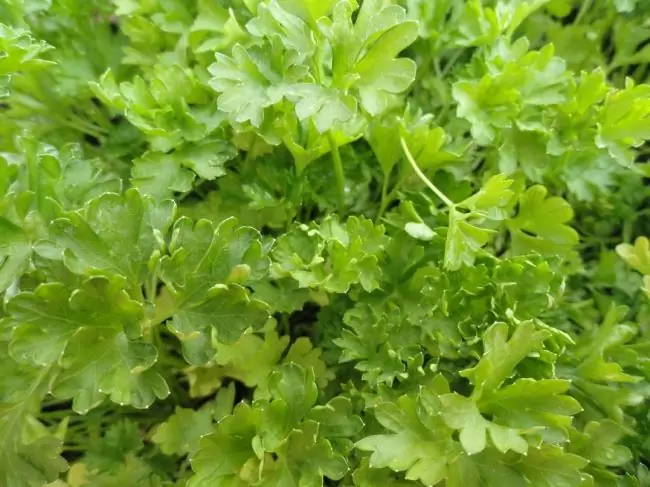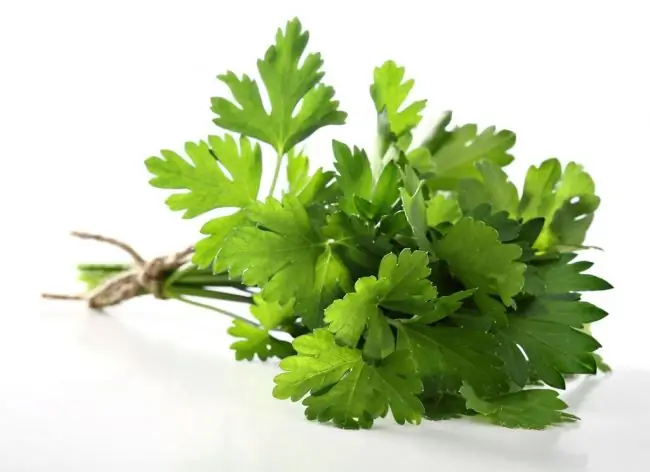- Author Arianna Cook [email protected].
- Public 2023-12-17 14:23.
- Last modified 2025-01-23 09:40.
All about parsley. Why it should be eaten and what useful properties it contains, as well as its use in medicine. Composition of vitamins and microelements of stone celery.
What is "stone celery"
Parsley is a plant in the umbrella family. Literally its name is translated from the Greek language "stone celery". It is a green grass. Has a spicy aroma. Parsley is common in Europe and Russia. The grass is not whimsical in growing in the garden and at home.

Parsley blooms in early summer, and it bears fruit from late summer to early autumn. The seeds are gray-brown in color. This plant loves water, but in moderation. If there is not enough moisture, then there will be no shoots. During the growth of the plant, it needs to be moistened in moderation, then the parsley will give a rich harvest. She is resistant to temperature changes and loves cold more than warmth. Parsley can even endure the winter under the snow. However, in the second year of life, it requires a change in temperature in favor of a warm one. Stone celery loves to be in the sun. If it is not enough for its growth, then the grass becomes sick and disappears.
"Golden" composition: vitamins and calories
Already among the Greeks, it belonged to the sacred plants. And its medicinal properties were known long before their appearance in Russia. It is one of the leaders among herbs, vegetables and fruits in the content of vitamin C. Eating it daily allows you to replenish the supply of the required daily value in this vitamin. This amount of vitamin C exceeds even the amount of C contained in lemon. Also, parsley overtakes carrots in beta-carotene content. This amazing herb also contains provitamin A in the amount necessary to meet the daily needs of the body.
Calorie content of parsley
per 100 g is only 47 kcal:
- Proteins - 3, 7 g
- Fat - 0.4 g
- Carbohydrates - 7, 6 g
It contains B vitamins, folic acid, potassium, magnesium and iron, flavonoids, phytoncides and inulin. Due to this composition, parsley is called a real "golden" reserve of vitamins.
Useful properties of parsley

Firstly, parsley is used in medicine. Thanks to the essential oil included in the composition, this plant becomes an excellent expectorant for colds, as well as a good antiseptic. For the treatment of diseases, seeds and herbs are used. Traditional medicine recommends parsley in the form of decoctions and infusions for the treatment of bronchitis, inflammatory processes and as a prophylactic folk remedy. Useful green juice is used to treat heart disease and to lower blood sugar. Therefore, for diabetics, parsley is a real salvation.
Also, this culinary spice is used as a diuretic. For this, a decoction of parsley is used. The same broth also serves as a medicine for inflammatory processes of the prostate gland, stones in the kidneys and ureter, malfunctions of the menstrual cycle, and for sexual incapacity. Parsley flawlessly cleanses the body, ridding it of toxins and extra pounds. Therefore, if you are overweight, it is recommended to drink daily infusion of this plant in combination with a decoction of fennel and dandelion leaves.
It also relieves irritation after insect bites, and especially from bees (just suppress a fresh bunch of greenery and anoint the bite). And its use as a remedy for bad breath can give it a leading position in dentistry.
The beneficial properties of parsley also fight against impaired vision, its combination with carrot juice gives a tangible result after a month of use.
Due to its beneficial properties, parsley is used in cosmetology as the main component of whitening masks. Its composition is able to help solve the problem of freckles on the face. The use of a decoction of the herb daily not only whitens the skin, but also makes it look younger and gives a healthy glow, as well as a tightening effect.
It is used in cooking as the main seasoning for meat and fish dishes, as well as in salads. Dried or fresh, culinary experts from all over the world create unique flavor combinations in dishes. It is also used very often to decorate dishes and give them freshness and originality.
Harm and contraindications
Parsley, despite its many advantages, like any other product, has contraindications and harm. It is unacceptable to eat the root of this plant during pregnancy. This can provoke a miscarriage.
It is also not allowed for inflammatory processes in the kidneys to take parsley juice. The same can be said for any inflammatory process in the body. You can not use the plant as food for cystitis. If available, parsley should be excluded from the diet.
The maximum allowable amount of green juice per day should be limited to four tablespoons. Otherwise, this plant can not only cause allergies, but also exacerbate chronic diseases.
Thus, the use of parsley presupposes knowledge of one's own body. Diseases in which its use is contraindicated should be a signal to exclude this plant from food. If the body has no contraindications to eating parsley or using it as a medicine, then its use can really be beneficial.
Video about the benefits of parsley
[media =






